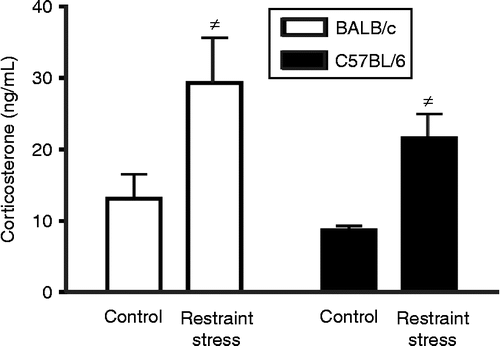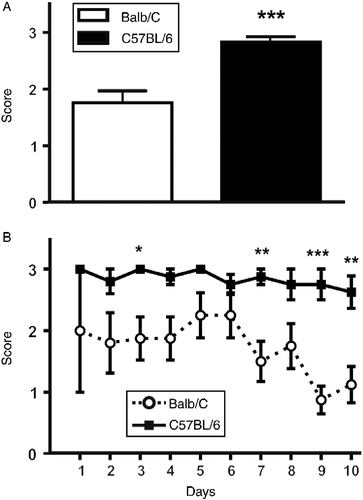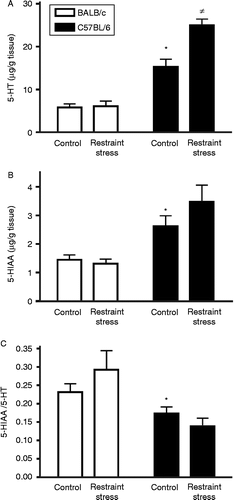Figures & data
Figure 1. Plasma corticosterone concentration as a result of chronic restraint stress. Mice were placed in restrainers for 2 h a day during 10 consecutive days. Plasma corticosterone was analysed 24 h after the last session of stress. Both strains showed a significant increase in plasma corticosterone concentration after chronic stress in comparison with non-stressed mice ( ≠ p < 0.005 by two-way ANOVA). No differences were found between strains. Data are expressed as mean ± SEM; n = 6–8.

Figure 2. Stress-induced alterations in defecation. During each restraint stress session, the faecal output was assessed using a scale ranging from 0 (no faeces) to 3 (diarrhoea). (A) Overall stress-induced diarrhoea was more common in C57BL/6 mice (*p < 0.005 by t-test). (B) An analysis of the daily defecation response shows that towards the end of the experiment the defecation score for BALB/c mice was close to 1, whereas scores for C57BL/6 mice remained high (close to a score of 3) throughout the experiment. Asterisks indicate differences between strains on a particular day (*p < 0.05; **p < 0.01; ***p < 0.005 by two-way ANOVA and Bonferroni test). Data are expressed as mean ± SEM; n = 6–8.

Figure 3. Colon monoamines. (A) Basal concentration of colon 5-HT was higher in C57BL/6 mice (*p < 0.0001 by two-way ANOVA), and stress elicited a significant increase in colon 5-HT only in the C57BL/6 strain ( ≠ p < 0.001; interaction p < 0.005 by two-way ANOVA). (B) Basal concentration of colon 5-HIAA was also higher in C57BL/6 mice (*p < 0.0001 by two-way ANOVA), with no effect of stress in either BALB/c or C57BL/6. (C) 5-HT turnover was higher in BALB/c mice (*p < 0.005 by two-way ANOVA), and it was not affected by stress in BALB/C or C57BL/6. Data are expressed as mean ± SEM; n = 6–8.

Figure 4. Serotonin-induced defecation. Faeces were counted and the occurrence of diarrhoea was scored from 0 (no faeces) to 3 (diarrhoea). (A) and (B) Vehicle-treated BALB/c mice displayed a higher faecal score than C57BL/6 mice (*p < 0.05; **p < 0.01 by two-way ANOVA). I.p. administration of 5-HT significantly increased faecal score in BALB/c and C57BL/6, although no differences were found between strains. (C) and (D) Vehicle-treated BALB/c mice produced more faeces than C57BL/6 mice (**p < 0.01; ***p < 0.005 by two-way ANOVA). 5-HT increased the number of faeces produced by BALB/c and C57BL/6 mice, with no effect of strain. (E) Incidence of diarrhoea at t = 10 min was higher for BALB/c than C57BL/6 mice at 0.33 mg/kg of 5-HT, but lower at 1 mg/kg (*p < 0.05 by chi-square test). Data are expressed as means ± SEM; n = 8.

